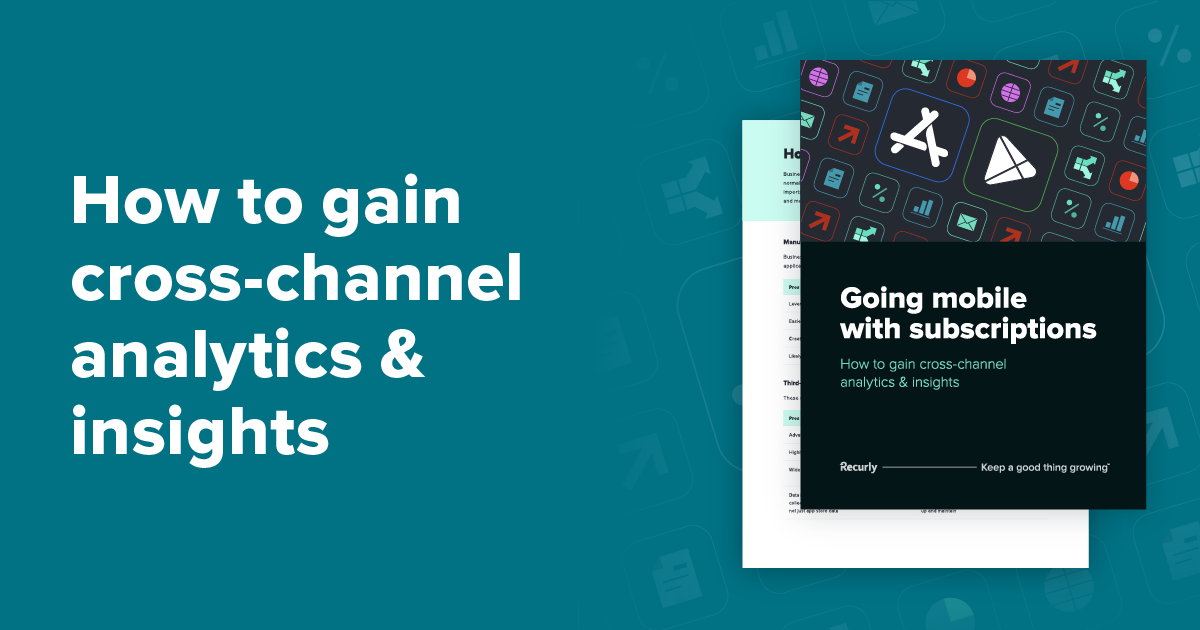How to gain data visibility in app store & web subscriptions

Did you know that 90% of the top-grossing apps in the Apple App Store monetize their products through subscriptions? It’s no surprise that companies are turning to recurring revenue models to propel growth. In fact, 62% of businesses already have–or are developing–a mobile app.
While it's a bold move to drive subscription growth, getting a full picture of data across web and mobile can be challenging. App stores don’t provide companies with meaningful analytics; their metrics come in rigid, unique formats, making it hard for businesses to gain a standardized data view.
Access to live and reliable multichannel analytics helps optimize recurring revenue streams, improve the subscriber experience, and increase efficiencies. Let us show you how to achieve it.

Cross-channel data visibility is challenging
The Apple App Store and Google Play are closed ecosystems that collect, store, aggregate, and share data in their own way. Businesses then have to transform it into a standardized format–bringing new challenges and operational costs to the company.
According to Gartner, poor data quality costs organizations an average of $12.9 million each year. This directly impacts revenue, increasing the complexity of data ecosystems and leading to poor decision-making.
Why the current solutions aren’t enough
Subscription businesses take various measures to normalize data and obtain a cohesive view across channels. However, these solutions result in a high risk of error and increased operational costs:
Manual exports and spreadsheets: These exports from the app stores and web applications bring the data into a spreadsheet for analysis. However, the process involves manual data manipulation, creating a higher risk of error.
Third-party integration and analytics tools: These are point solutions marketed primarily as revenue-tracking tools. The platforms are often expensive and have a separate UI to implement, learn, and use.
Pre-integrated subscription management solutions: This set of features within subscription management applications syncs web and mobile subscription data. However, they have a limited breadth of integrations, customization capabilities, and reports.
What can you do, then? 54% of companies that use advanced analytics have increased revenue.
Get data visibility with a multichannel analytics solution
While app stores make data aggregation a complex task, there are solutions designed to simplify and streamline cross-channel analytics. A multichannel subscription management solution helps businesses like yours save time, minimize licensing fees, and free internal resources.
The benefits of this option extend across stakeholders:
CPOs gain a cross-channel bridge in a single view that boosts insights and efficiencies
CTOs benefit from a scalable, prebuilt integration that saves development time and costs
CMOs realize budget and performance efficiencies through cross-channel insights
CFOs gain enriched performance metrics, facilitating accurate revenue recognition
Developers benefit from a fast, no-code or low-code setup using APIs and webhooks
Look for an automated, easy-to-configure solution that offers a cross-channel product catalog and the analytics your business cares about. Some platforms, like Recurly, also have entitlement management to ensure a single source of truth and support and ASC-606 and IFRS-15 compliance across web and mobile.
Want to learn more? Download our guide!
As mobile subscriptions grow, businesses must find reliable and efficient ways to synchronize subscription data to obtain the key performance metrics and insights they need to make more informed decisions.
Download our guide to gain cross-channel subscription analytics and insights to delve into the challenges of web and mobile subscriptions, the importance of cohesive metrics to bring focus, and what to look for in an analytics solution to propel your business forward.


